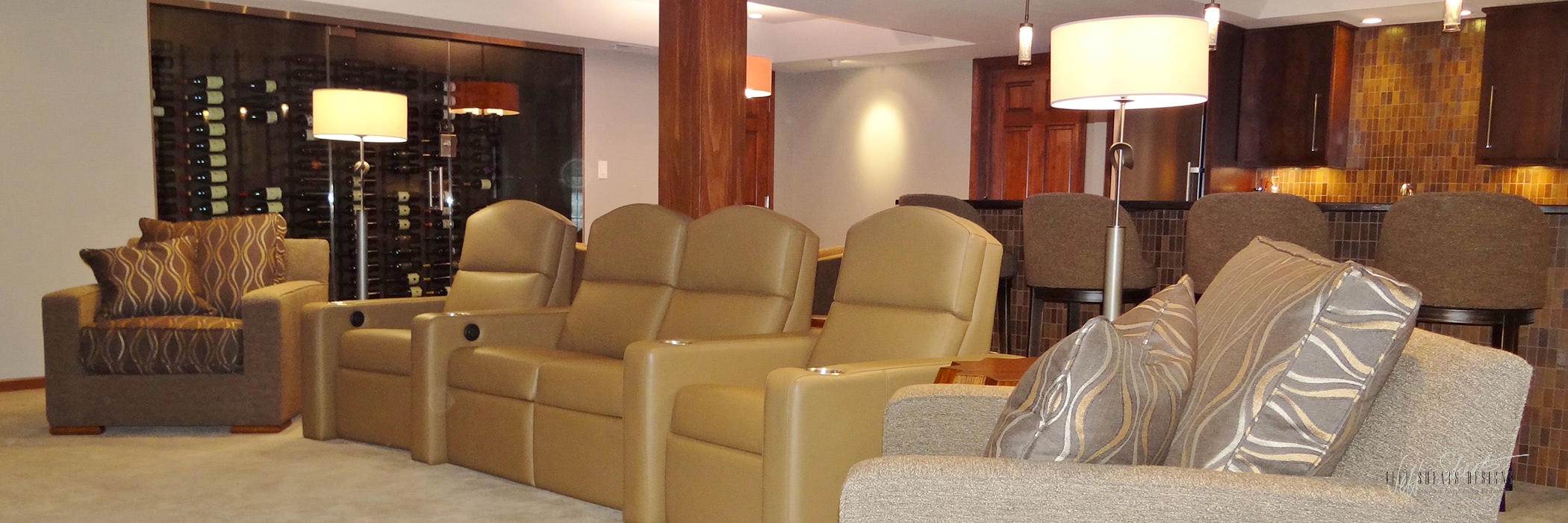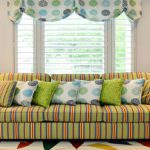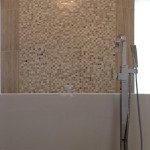The Home Theatre for Every Household
In 2014, the NY Daily News reported the average American watches television an astonishing five hours per day. This is true unless you are over 65 – then you watch over seven hours per day. With the continual decrease in TV unit costs and increase in ways to access TV shows and movies, more Americans are spending time in front of a screen at their home. The Motion Picture Association of America reports ticket sales fell almost 5% from 2013 to 2014.
Americans admit that although they like the feeling of escape and the enhanced picture and sound quality a traditional movie theatre provides, they find the comfort of their own home more gratifying when watching a film or sporting event. As professional residential interior designers, we are always responsible for investigating our client’s lifestyle, viewing habits, and comfort requests. These insights allow us to determine the ultimate direction for space planning and furnishing a residence with a simple TV viewing experience and for homes with an elaborate custom home theatre.
There are a multitude of factors for an interior designer to consider upfront but great space planning always takes center stage. Which area of the home is most suitable for a home theatre? Will the TV be a focal point or will it be integrated into the room’s design with multiple focal points? The size, style, and placement of the TV matters greatly, as well as the location of the media equipment that is driving the content and sound. Sound requirements, speaker locations and controls are very important. Ultimately the scale of the home theatre space will dictate seating area and seating type, such as reclining versus stationary upholstery which are key factors to select early.
Which Theatre Style is Right for You – And Your Budget?
For an interior designer to properly set up a basic home theatre, it is important to determine how to allocate the space for comfortable and convenient viewing while allowing the room to function and serve other purposes as well, especially if space is at a premium. The absolute best way to do this within casual living spaces is to create a flexible seating plan that allows for TV viewing, but also for other activities when the TV is off. In a more modest budget environment, the TV should be scaled well to fit atop, inside or wall mounted above a simple media cabinet. The cabinet should be large enough to hold all your existing media components, including a DVR, DVD BluRay player, video game console, sound receiver, and any components you might incorporate in the future. A basic design plan will allow all your media equipment remotes to operate each device through glass front cabinet doors or via open shelves. Basic cable management can be accomplished through a back panel of a media cabinet to organize and bundle all cords. Some mid-level upgrades to this basic set up might include adding in-wall or in-ceiling recessed speakers and an external subwoofer in a five or seven channel surround sound arrangement. Today’s flat panel TVs still do not have great sound quality with their very thin integrated speakers. Another mid-level upgrade is adding an articulating arm behind the TV to angle the monitor as needed thus providing multiple viewing angles in a single space.
For The Ultimate Home Theatre
If your home and budget allows for an entire room to be designated as the theatre, there are additional opportunities to create a remarkable viewing and listening atmosphere. Planning a home theatre with a designer and their preferred A/V specialist is a great approach to creating a masterful home theatre. Initial considerations for the design would again center on the space plan including where the TV and media components would be located with acoustical issues also addressed early. Wall mounting the TV or deploying a large drop down screen and projector plus deleting all media storage furniture can create a much cleaner aesthetic. Ray Rice, President of Digital Sight and Sound, a Carmel-based A/V integrator states “Furniture pieces and built-ins used as exposed media cabinets are always more difficult and time-consuming to wire to A/V equipment. It is much simpler to wire a remote rack of equipment to drive your television viewing experience. Obviously it is easier to prewire a new home during construction, but existing homes can more easily be accommodated as well these days.” With a remotely located equipment rack, better access is attained and your equipment can easily be updated over time. Adding a quality surround sound system throughout the theatre adds volumes to the movie-going at home experience.
Like a basic home theatre, the premium starting point for a high-end custom theatre room is space and equipment planning that incorporate furnishings that are flexible to the user. Reclining seats or sofas are both very comfortable and functional custom seating options. Many current styles can be upgraded to feature cup holders, USB ports, power reclining, heating and massage options, as well as tablet holders and storage for remotes. Laying out the room in rows allows many occupants to be seated and maximizes views to the screen. A theatre can also act as a reading or study space when not in use. To up the ante for your dream home theatre, a designer will layer in another key component to controlling the atmosphere and setting your favorite scene – dimmable and dramatic lighting. The addition of motorized blackout shades or draperies another great opportunity for natural lighting control and for optimal screen viewing. Designers also consider acoustical wall and ceiling treatments, floor coverings and overall color schemes and evoking a certain feeling to create the optimum theatre experiences.
Another huge impact of component space planning today is the integration of your home and the internet. Controlling the whole house including your theatre, window treatments, lighting, HVAC and security via your iPhone, iPad or laptop is a current and exciting reality which requires additional planning and equipment. Designing around all these technologies and components can be daunting, so consulting your professional interior designer early will always yield best results and will provide you the amazing home theatre space you have been dreaming about.
Please feel free to contact us via telephone at (317) 357-0155 with any questions about this material or to request more information about our services. Visit the It’s YouTM section on our website at www.jeffsheatsdesigns.com to learn more about the Jeff Sheats Designs, Inc. interior design process. We are your partners in interior design!



